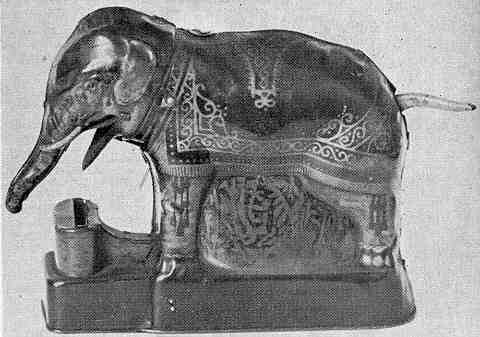Royal "Trick" Elephant Bank
by F.H. Griffith - HOBBIES Magazine - November, 1960

An interesting group of mechanical banks is comprised of elephants of different types and sizes performing a variety of tricks involving the use of coins in their action. The appropriately named Royal "Trick" Elephant Bank, one of the most unusual in the group, is our choice as No. 89 in the numerical classification of mechanical banks. The name is quite appropriate since the elephant is most certainly decorated in a lavish royal manner and he does do a neat trick with a coin.
Definite background information on the bank, as to the origin, maker, time of manufacture, and so on, is sadly lacking. There are no markings, dates, numbers, or anything else on the bank itself that would help to identify it. No catalogs of any type known to the writer either picture or describe the bank for sale. There are some things, however, concerning the bank that we can be reasonably sure of. For one thing there is no question but that it is of foreign make and most probably of German manufacture. It has characteristics in common with the Cross Legged Minstrel for example, and this is a known foreign product. Also the Royal "Trick" Elephant Bank is made of tin, similar to some of the other known imported mechanical banks. The locking tin coin trap in the base is identical to several of the German made banks. Other factors, all indicative of the same foreign source, have to do with the colors of the bank, and the way it is made. As to the period of the bank there is not much to go on, but most likely it dates around 1890 to 1910.
The bank shown is in fine original condition and is in the extensive collection of John D. Meyer. On the occasion of a recent visit with Mr. Meyer the writer had the pleasure of examining several mechanical banks in his collection, and in particular the bank now under discussion, and the Snake And Frog In Pond. Both of these banks are quite unique and rather difficult to describe unless seen first hand. Mr. Meyer’s Royal "Trick" Elephant Bank was formerly in the collection of the late James C. Jones and it was one of Mr. Jones’ favorite banks. He was particularly fond of elephants and in addition to his collection of mechanical banks he also had quite a collection of elephants in ivory, bronze, and other materials. Naturally any mechanical bank that had to do with an elephant had a particular appeal to him.
The bank, as stated above, is very ornately decorated. The base is red; and the coin holder, and the section between the legs of the elephant have representations of green foliage. The elephant itself is a tan and green color with shading and blending of the two colors. There is a red blanket or robe covering the elephant’s body. This has gold fringe around the edges and red tassels hanging down each of the legs. In addition there is blue and gold bordering and other decorations on the robe. There is a striped blue and red hood over the head of the elephant and this has red tassels hanging over the front of the ears and down the front of the trunk. All lettering on the bank is in black. On each side of the red base the following verse appears:
"Put a coin in the slot then you’ll see something funny.
Press my tail hard and I’ll swallow the money."
On the front of the red base appears the name "Royal ‘Trick’ Elephant Bank." The following wording appears on each side of the base just under the coin holder, "Place Coin Here," and there is an arrow pointing up to the coin holder. The verse refers to this section as having a slot, which it does, however, in normal reference to a coin slot an entrance for the coin is indicated. In the case of this bank the slot is actually a resting place for the coin, or a coin holder, since the coin does not enter the bank through this slot.
The operation and mechanism of the bank is fast and efficient. A coin is first placed in the slot as directed and then the tail is pressed. In so doing a V-shaped piece in the slot on which the coin rests snaps up and throws the coin rapidly upward. At the same time the elephant’s head and trunk bend down so that the coin goes into the mouth with perfect precision. The action of the coin is actually so fast that it seems to disappear and it is necessary to watch closely in order to see the coin enter the mouth. Releasing the tail automatically returns the working parts to the position shown in the picture.
The Royal "Trick" Elephant Bank is an intriguing mechanical bank and it offers a good challenge to the collector since only a few specimens of the bank have turned up to date.
